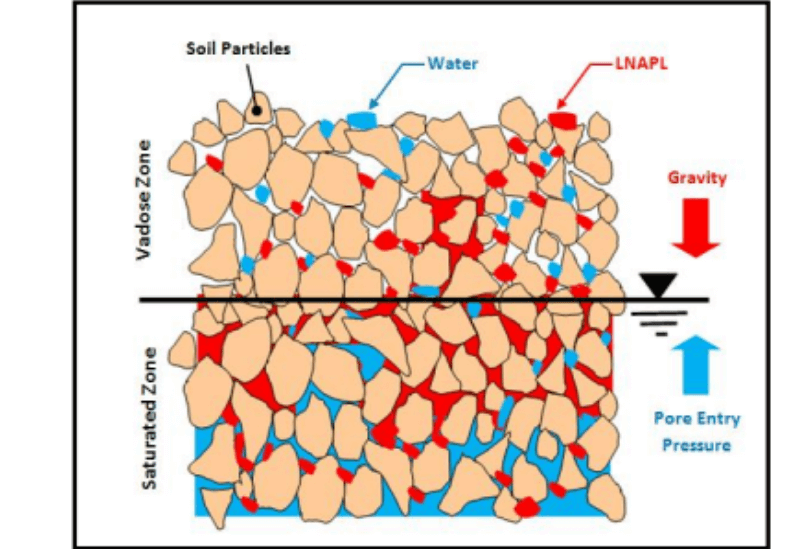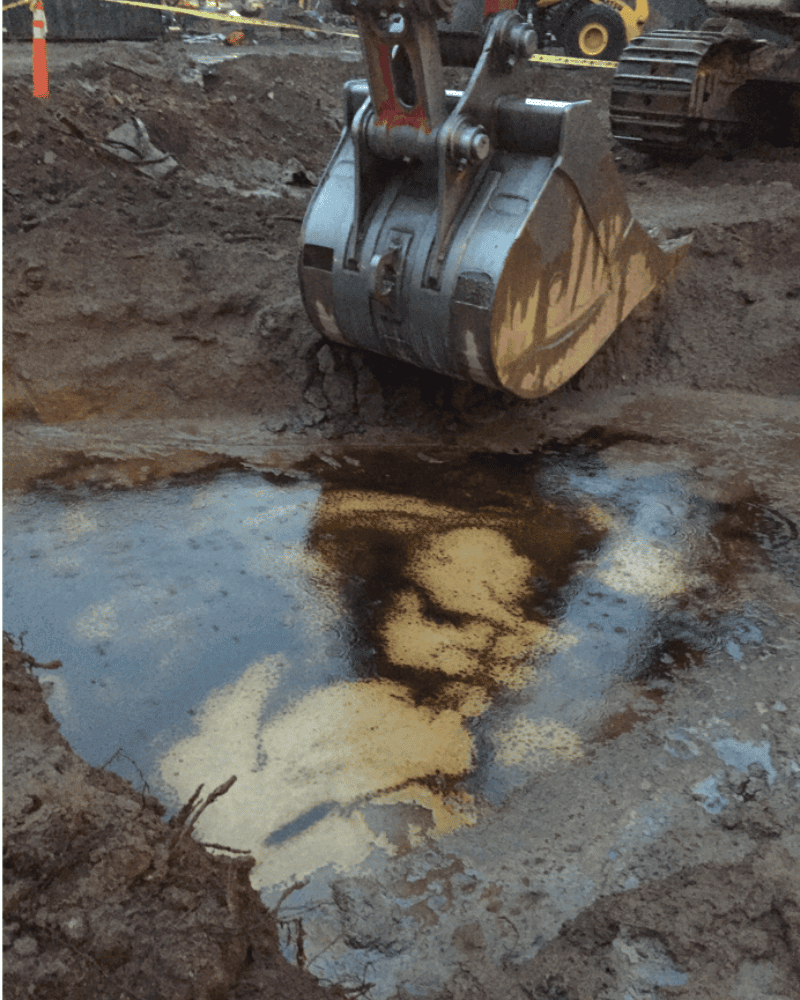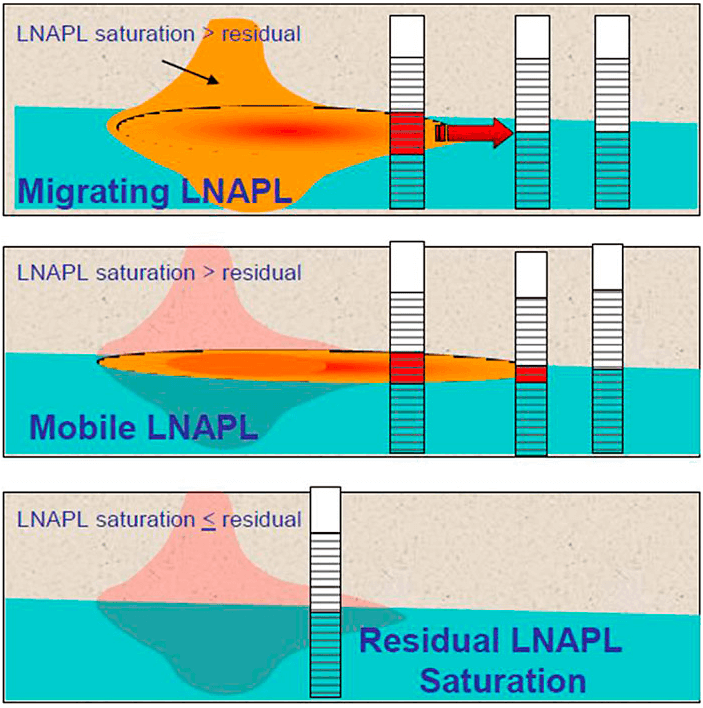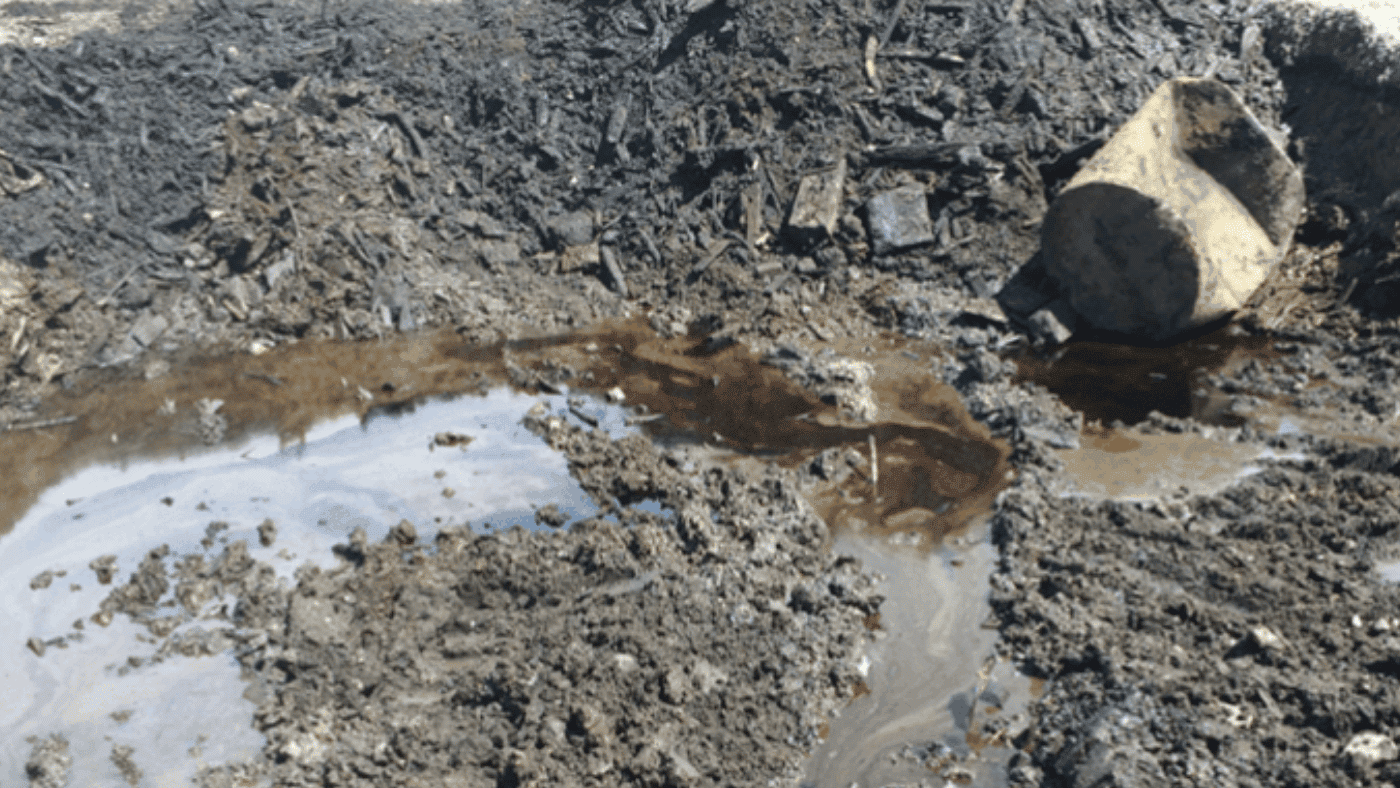Every property has a history and unique qualities shaped by natural and human activities. Some of those human activities have left contaminants and pollution on the site, which has environmental risk that needs to be assessed and managed through remediation. One type of contaminant is called light non-aqueous phase liquids, which gets into the ground to cause issues.
What is LNAPL?
Light non-aqueous phase liquid (LNAPL) generally refers to a separate and immiscible phase liquid when in contact with water. Immiscible means it is incapable of being mixed or blended together. Like oil and vinegar, if LNAPL and water are mixed together in a bottle, the liquids would separate into layers.
LNAPLs are usually petroleum hydrocarbon liquids that are less dense than water at ambient temperature and the chemical differences results in the formation of a physical interface between the liquids which prevents the fluids from mixing. In the subsurface environment, LNAPL can exist in a continuous (mobile) phase or a discontinuous mass (immobile). As LNAPL is less dense than water, the separate phase hydrocarbon can be observed to be floating on the groundwater if the LNAPL is mobile.

Environmental Effects of Light Non-Aqueous Phase Liquids
If there is a discharge of petroleum at a site, at one time, LNAPL are likely present in the subsurface as a source area, whether it be a smaller or larger amount. LNAPLs negatively impact both the soil and groundwater, and when they are detected, they increase the complexity of investigation and remediation at many sites.
The complexities of LNAPL contaminated sites are sometimes brought about by common misconceptions about how LNAPL behaves in the subsurface environment. An understanding of how LNAPL behaves in the subsurface could aid in the development of a more informed conceptual site model (CSM) that will ultimately lead to a better executed investigation and remediation of a site.

Common Misconceptions about LNAPL
Presence/Absence of LNAPL in Monitoring Well
The presence of LNAPL in a monitoring well is a daunting sight for many field samplers and responsible parties. The presence of LNAPL alone indicates that LNAPL is mobile (flowable); however, does not mean that the LNAPL body is migrating.
Also, the absence of LNAPL in a well does not indicate that there is no LNAPL present in the surrounding area. If the LNAPL in the soil adjacent to the well is below residual saturation (not mobile), then LNAPL will not flow into and appear in the well.
Measured LNAPL in a Well
The LNAPL thickness in a monitoring well can be exaggerated when compared to the LNAPL thickness in the surrounding formation. Water table fluctuations can impact how much LNAPL is observed in a well. Under unconfined conditions, the LNAPL observed in a monitoring well may increase as the groundwater table falls, which allows for LNAPL to flow into the well. As the groundwater level rises, LNAPL can become entrapped (non-mobile) in the saturated soil and the observed LNAPL thickness in the well would decrease.
Another fairly common situation is LNAPL accumulation under perched conditions, where the screened interval of a monitoring well extends deeper below the perched zone and LNAPL can flow into the well which acts as a reservoir and will appear to have a much larger LNAPL thickness in the monitoring well, than what is in the surrounding formation.
LNAPL Migration
LNAPL bodies associated with a single discharge event will generally stop migrating within a relatively short timeframe. Initial and primary migration occurs due to the LNAPL “head” distribution. LNAPL “head” is the height of the LNAPL at the release site above the water table. LNAPL migration is not always in the same direction of groundwater flow and could be occurring due to differences in hydraulic gradients or may migrate along dipping impermeable layers (e.g., clay lenses).

LNAPL Distribution
There is some belief that LNAPL floats on top of the water like a pancake and does not penetrate below the water table. It is true that LNAPL can be encountered floating on the water table; however, LNAPL may also be present in the saturated zone. LNAPL can exist in continuous or discontinuous form beneath the water table; the former of which can be mobile (and possibly amenable to hydraulic recovery). This is especially true at sites where the water table elevation fluctuates.
LNAPL and Dissolved Phase Groundwater Plumes
There is a misconception that hydraulic recovery of LNAPL will result in decreases of contaminant concentrations in the underlying groundwater. The hydraulic recovery of LNAPL from the subsurface is limited by the transmissivity. Lower transmissivity values are associated with immobile LNAPL and are dependent on factors such as soil type, LNAPL saturation and thickness. Residual LNAPL is present when LNAPL occupies a fraction of the soil pore space and is discontinuous and mobility does not occur. Once LNAPL is no longer recoverable by hydraulic means (i.e., pumping), residual LNAPL will continue to impact groundwater quality.
Natural Source Zone Depletion (NSZD)
This concept recognizes that the mass at LNAPL sites can be reduced by natural processes such as volatilization, absorption, degradation, and dissolution. This process has often been under-recognized by practitioners and regulators. NSZD is likely occurring to some degree at all LNAPL sites; however, many states will not allow for NSZD as a primary remedial measure to address LNAPL and initial removal, containment and stabilization measures (engineering controls) must be implemented, especially where receptors are potentially being impacted. NSZD may be more likely as the final step in the remediation process after other active remedies have been implemented and are no longer effective or practical. Long term performance monitoring and risk management are key components of long term NSZD remedies.
How can VERTEX help?
VERTEX has experience conducting LNAPL investigations and remedial actions in different subsurface environments across the country. An example of an innovative approach to remediate LNAPL was the implementation of an in-situ stabilization (ISS) remedy after years of LNAPL recovery effort and cost from well points. The approach focused on remediating LNAPL over a nearly 0.75-acre area (17,000 cubic yards) where No. 4 fuel oil LNAPL was impacting the subsurface to depths of 24 feet below grade. This was a first-of-its-kind project implemented under New Jersey’s Unregulated Heating Oil Tank Program. The LNAPL area was divided into 67 manageable cells where ISS mixing occurred at depths from 12 to 24 feet below ground surface. The performance metrics were based on uniform compressive strength of the ISS body and permeability measurements as determined by testing and met the stated objectives.
VERTEX is currently tackling another failed LNAPL recovery effort that continued for 20 years below an active fire house that was being implemented by others. VERTEX’s innovative approach involves LNAPL extraction wells and horizontal injection to recirculate nutrient and oxygen enriched water to bioremediate the LNAPL without disrupting fire house operations.
VERTEX’s Environmental and Engineering Experts can partner with you to resolve similar complex challenges.
To learn more about VERTEX’s Environmental Consulting services or to speak with an Environmental Expert, call 888.298.5162 or submit an inquiry.




